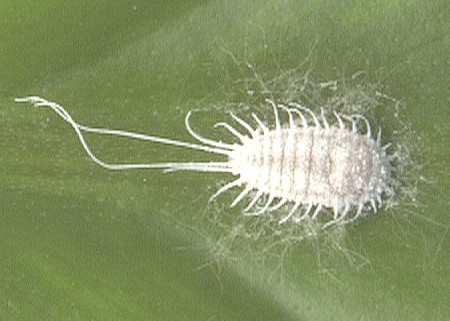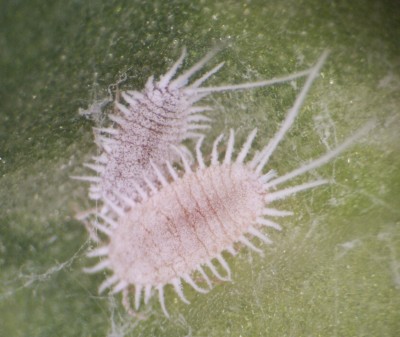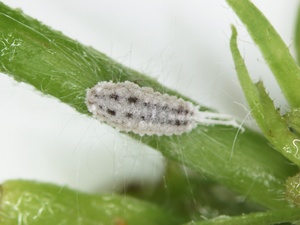Mealybugs
 Hosts
Hosts
Houseplants.
Symptoms
 Of the many species that may occur on greenhouse floral crops, probably the most common
one is the citrus mealybug. Mealybugs injure plants by sucking juices from tender
foliage and roots of many greenhouse crops. Heavy infestations result in stunted and
distorted new growth. Additionally, like many other insects, honeydew is excreted
which gives rise to black sooty mold.
Of the many species that may occur on greenhouse floral crops, probably the most common
one is the citrus mealybug. Mealybugs injure plants by sucking juices from tender
foliage and roots of many greenhouse crops. Heavy infestations result in stunted and
distorted new growth. Additionally, like many other insects, honeydew is excreted
which gives rise to black sooty mold.
Life Cycle
 The life cycle of most species is similar with females laying 300 to 600 eggs in compact
waxy sacs attached to axils of stems or leaves. After egg laying, females die and
the eggs hatch in 7 to 10 days into tiny yellowish crawlers (nymphs). The long-tailed
mealybug is slightly different in that females give birth to living young. The complete
life cycle can take six weeks to two months depending on the species and the environmental
conditions. Breeding and development, however, is year-round in the greenhouse.
The life cycle of most species is similar with females laying 300 to 600 eggs in compact
waxy sacs attached to axils of stems or leaves. After egg laying, females die and
the eggs hatch in 7 to 10 days into tiny yellowish crawlers (nymphs). The long-tailed
mealybug is slightly different in that females give birth to living young. The complete
life cycle can take six weeks to two months depending on the species and the environmental
conditions. Breeding and development, however, is year-round in the greenhouse.
Description
Mealybugs are soft-bodied insects that are about 1/8-inch in length. They have a white powdery substance over their bodies and white, waxy filaments projecting from the rear of their bodies. They are unarmored but have a rubbery outer coating that cannot be detached. They may be flat, oval, or globular, and some secrete wax.
Control
Please contact your local county extension office for current information.
